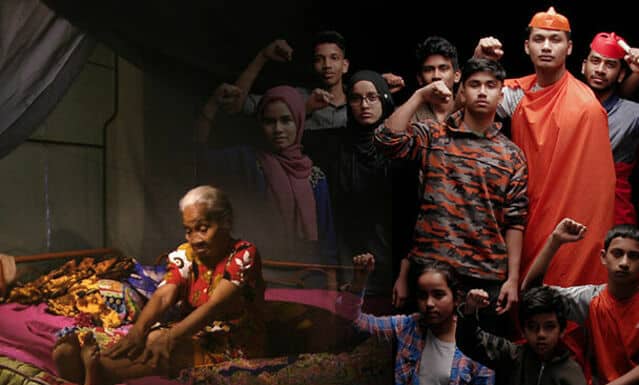Two of our On Demand films this month depict the stories of survivors who have overcome the most violent human rights atrocities in Burma and Indonesia. I AM ROHINGYA and THE LOOK OF SILENCE condemn the persecution of communists and Muslim minorities, while bringing a reflective and humane quality to weighty narratives of state violence and injustice.

Still from I AM ROHINGYA 
Still from I AM ROHINGYA
I AM ROHINGYA
I AM ROHINGYA / Yusuf Zine / Canada / 2018 / 90 ‘ / English
I AM ROHINGYA, by director Yusuf Zine, brings documentary theatre to the screen in an interpretation of migrants’ journeys from Burma, to refugee camps in Bangladesh, to finally resettling in southwestern Ontario.
Sunni Muslims form a minority in Burma and have endured a genocide against them in the Kachin, Rakhine, southern Chin and Shan States. Amid official claims that there is no religious discrimination in Burma, and the added complexity of poverty that has also contributed to mass displacement, around 1.3 million Muslims are known to have been imprisoned in Myanmar.
Between 2015-2017, the forced displacement of Muslims and other minorities from Burma to Bangladesh, Cambodia, Indonesia, Laos and Malaysia received much media attention. Yet, Western nations have largely remained quiet on the Rohingya genocide, with persistent calls for UN action coming instead from Iran—bringing to light the selective silence of the alleged western beacons of democracy.
All this has occurred under the icon of the liberal left, Burma’s de-facto leader and Nobel Peace Prize winner Aung San Suu Kyi, who has been increasingly criticized for her lack of decisive action against the massacres by Burmese military and security forces.
The 2018 Cinema Politica Audience Choice Award winner, I AM ROHINGYA has previously screened at Cinema Politica Concordia, where director Yusuf Zine spoke about the significance of working with children and youth in bringing their stories to life. Under his direction, I AM ROHINGYA follows 14 Rohingya refugees – untrained, first-time actors – as they recreate their stories of witnessing and surviving genocide. Channeling their experience and muscle memory, they use theatre as a means to transcend their traumas, and challenge the audience to live through them.
As one of the young actors in Yusuf Zine’s play describes, “It can change the future for a lot of people. It can change what they see in the future. They don’t want to see blood, they want to see the sunset.”

In The Look of Silence, Indonesian optician Adi Rukun, pictured here in a scene from the film with his mother, investigates the murder of his older brother in mass violence following a 1965 coup. Perpetrators and their relatives “would taunt us for being their victims,” he says. 
Still from THE LOOK OF SILENCE
THE LOOK OF SILENCE
THE LOOK OF SILENCE / Joshua Oppenheimer / United States – Indonesia / 2014 / 103 ‘ / Indonesian, English
Joshua Oppenheimer’s critically acclaimed THE LOOK OF SILENCE — which follows up his 2012 film THE ACT OF KILLING — continues the difficult and disquieting project of seeking justice for the survivors of the Indonesian genocide of 1965-66. At the centre of the documentary is optometrist Adi Rukun, who confronts the psychological toll the genocide has had on his family, provoking questions about how the denial of state violence could lead to a repetition of history.
The anti-Communist purges that brought the Suharto dictatorship to power have claimed the lives of at least half a million, with estimates of up to a million people suffering brutal killings, rape and torture, and kidnappings. The Indonesian military (TNI) is also known to have targeted ethnic Chinese, trade unionists, teachers, activists and artists. But even today, efforts to accurately report the casualties and total death toll have been inconclusive.
In Indonesia’s pervasive climate of censorship, the TNI has long denied the characterization of its atrocities as genocide, calling it a defence against the Communist Party – which formed the political opposition to the Armed Forces in the 60s – avoiding accountability for decades.
The impacts of the Indonesian genocide in ’65-66 cannot be underestimated, with an impact that reaches far beyond the borders of Indonesia. As journalist Vincent Bevins documents in The Jakarta Method, the mass killings by TNI in turn influenced the US anti-Communist assassination and terror campaign across South America, known as Operation Condor. This covert operation claimed the lives of just under a million leftists or sympathizers, and imprisoned half a million.
US interference notwithstanding, Canada itself armed the brutal Indonesian dictatorship between the 70s and 90s, following Suharto’s rise to power in 1968. Back in 2000, policy analyst Asad Ismi had documented Canada’s extensive arms exports during this period.
Through exquisite cinematography, Oppenheimer’s THE LOOK OF SILENCE explores the heavy emotional burden that is carried by survivors who have to confront a reality of living alongside their torturers. Many who were involved in the paramilitary death squads lead ordinary lives as local politicians and teachers, while denying the atrocities of the genocide. Spellbinding and severe, this poetic film focuses on the resilience of humanity despite what seem to be insurmountable conditions.


